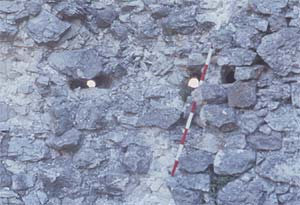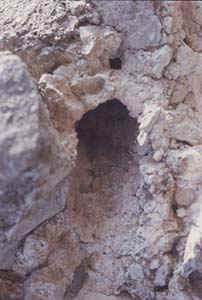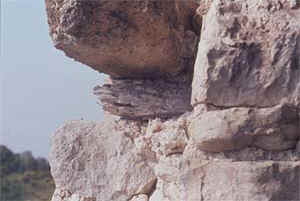 Fortifications
Fortifications
 The
opus gallicum in the fortifications
The
opus gallicum in the fortifications
The
presence of a curious wall bond consisting of timber elements inserted in the
stone masonry and serving a structural function can be observed in many Molisian
fortifications. After the deterioration of the wooden elements only the
casements remain, which must not be confused with the putlog holes. The
arrangement of poles or beams (sometimes they form a real framework) still
leaves doubts regarding the actual static contribution given to the masonry
structures. The idea that this represents a construction abnormality, a naive
attempt to bind parts of the masonry, should be reconsidered in light of the
growing number of such structures that are being discovered. The procedure is
very old (it was already used in the terrepleins of protohistoric times) and was
described by Julius Caesar (De Bello Gallico). Rather common in the
architecture of the Middle Ages, this system continued to be applied until more
recent times.
The Molisian examples concern particularly the fortifications, structures for
which quick execution was an important factor. The most interesting examples are
found at the castle of Roccamandolfi and at the Magliano tower in the town of
S.Croce. In the former case we find rows of holes located one above the other at
sufficiently regular intervals in the wide escarped curtain wall and in the
walls of the “chevalier” towers; at the Magliano tower, the remaining holes
outline a double mesh of bars: radial to the masonry with a small circular cross
section, and longitudinal with a larger four-sided section. Other examples exist
in Longano (Riporse castle) and Palata (Castellerce ruins).
 |
Roccamandolfi |
 |
Magliano |
 |
Magliano |
 |
Roccamandolfi |
|
|



![]() Fortifications
Fortifications![]() The
opus gallicum in the fortifications
The
opus gallicum in the fortifications



